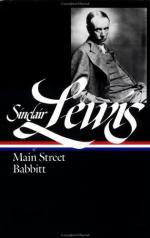“Now the point of this is: I’m not only insisting that Gopher Prairie is going to be Minnesota’s pride, the brightest ray in the glory of the North Star State, but also and furthermore that it is right now, and still more shall be, as good a place to live in, and love in, and bring up the Little Ones in, and it’s got as much refinement and culture, as any burg on the whole bloomin’ expanse of God’s Green Footstool, and that goes, get me, that goes!”
Half an hour later Chairman Haydock moved a vote of thanks to Mr. Blausser.
The boosters’ campaign was on.
The town sought that efficient and modern variety of fame which is known as “publicity.” The band was reorganized, and provided by the Commercial Club with uniforms of purple and gold. The amateur baseball-team hired a semi-professional pitcher from Des Moines, and made a schedule of games with every town for fifty miles about. The citizens accompanied it as “rooters,” in a special car, with banners lettered “Watch Gopher Prairie Grow,” and with the band playing “Smile, Smile, Smile.” Whether the team won or lost the Dauntless loyally shrieked, “Boost, Boys, and Boost Together—Put Gopher Prairie on the Map—Brilliant Record of Our Matchless Team.”
Then, glory of glories, the town put in a White Way. White Ways were in fashion in the Middlewest. They were composed of ornamented posts with clusters of high-powered electric lights along two or three blocks on Main Street. The Dauntless confessed: “White Way Is Installed—Town Lit Up Like Broadway—Speech by Hon. James Blausser—Come On You Twin Cities—Our Hat Is In the Ring.”
The Commercial Club issued a booklet prepared by a great and expensive literary person from a Minneapolis advertising agency, a red-headed young man who smoked cigarettes in a long amber holder. Carol read the booklet with a certain wonder. She learned that Plover and Minniemashie Lakes were world-famed for their beauteous wooded shores and gamey pike and bass not to be equalled elsewhere in the entire country; that the residences of Gopher Prairie were models of dignity, comfort, and culture, with lawns and gardens known far and wide; that the Gopher Prairie schools and public library, in its neat and commodious building, were celebrated throughout the state; that the Gopher Prairie mills made the best flour in the country; that the surrounding farm lands were renowned, where’er men ate bread and butter, for their incomparable No. 1 Hard Wheat and Holstein-Friesian cattle; and that the stores in Gopher Prairie compared favorably with Minneapolis and Chicago in their abundance of luxuries and necessities and the ever-courteous attention of the skilled clerks. She learned, in brief, that this was the one Logical Location for factories and wholesale houses.
“There’s where I want to go; to that model town Gopher Prairie,” said Carol.
Kennicott was triumphant when the Commercial Club did capture one small shy factory which planned to make wooden automobile-wheels, but when Carol saw the promoter she could not feel that his coming much mattered—and a year after, when he failed, she could not be very sorrowful.




